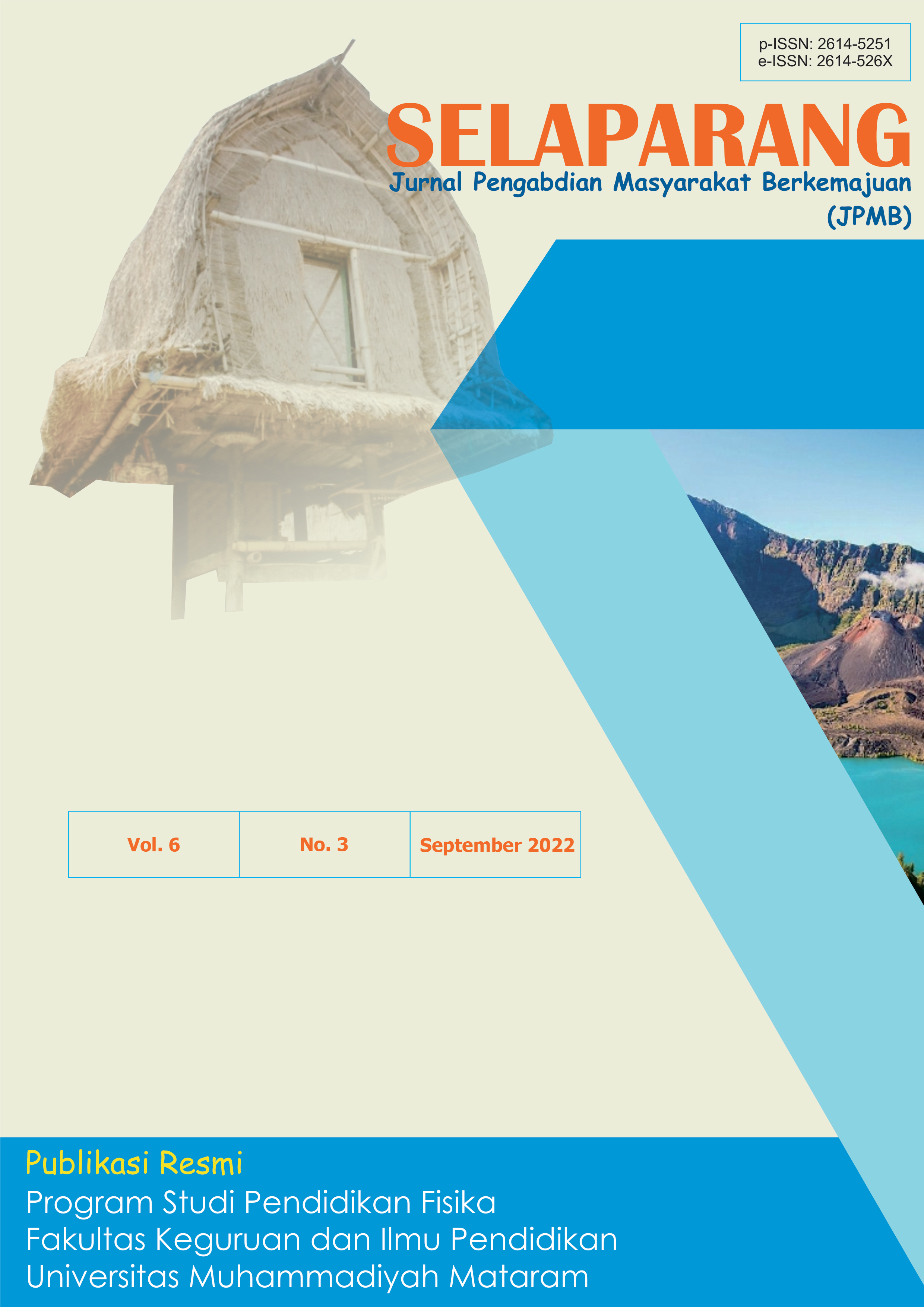PELATIHAN ANALISIS MAKROINVERTEBRATA SEDERHANA SEBAGAI BIOINDIKATOR KUALITAS SUMBER AIR MINUM DI DESA KEMIRI, KECAMATAN PANTI, KABUPATEN JEMBER
DOI:
https://doi.org/10.31764/jpmb.v6i3.9249Keywords:
bioindicators, kemiri, macroinvertebrates, training, and waterAbstract
ABSTRAK
Masyarakat Kelompok Tani Sidodadi, Desa Kemiri, Kecamatan Panti, Kabupaten Jember menjalankan pertanian sebagai sumber pendapatan utama. Sumber daya air sebagai baku pertanian menjadi berkurang kualitasnya seiring pencemaran. Air minum masih menggunakan air dengan kualitas yang kurang baik. Namun, penentuan kualitas air untuk pertanian masih belum banyak dikenal, terutama menggunakan makroinvertebrata sebagai indikator alami. Sangat penting dilakukan pengayaan pengetahuan melalui pelatihan dan sosialisasi terhadap masyarakat mengenai jenis makroinvertebrata tersebut. Selain itu, sangat penting juga dilakukan sosialisasi teknik konservasi dan perlindungan sumber daya air, sehingga nilai guna sumber daya air akan terjaga, baik kuantitas, kualitas, maupun kehandalannya menjadi sumber baku irigasi. Teknik pengenalan dan identifikasi ini juga disampaikan pada masyarakat agar kualitas air baku pertanian tetap terjaga. Kegiatan utama adalah peningkatan kualitas air melalui pengenalan jenis makroinvertebrata air dengan tujuan meningkatkan pengetahuan masyarakat tentang kualitas perairan di sekitarnya dan meningkatkan kualitas kesehatan petani. Setelah itu, dilakukan pengayaan pengetahuan melalui pelatihan dan sosialisasi terhadap masyarakat mengenai jenis makroinvertebrata, terdapat penambahan pengetahuan yang baru yang dirasakan oleh peserta. Peserta kemudian mampu memahami penentuan kualitas air dengan menggunakan berbagai metode analisis kualitas air. Metode analisis kualitas air dapat diterapkan dengan menggunakan indra, metode fisik, dan bioindikator. Selain itu, peserta menyadari pentingnya menjaga kualitas air.
Â
Kata kunci: air; bioindikator; kemiri; makroinvertebrata; dan pelatihan
Â
ABSTRACT
The Sidodadi Farmers Group, Kemiri Village, Panti District, Jember Regency, depend on agriculture for their livelihood. Water resources for irrigation are decreasing in quality along with pollution. People drink with low quality water. However, the determination of water quality for agriculture is still not widely known, especially using macroinvertebrates as bioindicators. Based on initial observations, it is very important to enrich knowledge through training and outreach to the public regarding the types of macroinvertebrate bioindicators. In addition, it is also very important to disseminate techniques for conservation and protection of water resources. This has an impact on the stability of the condition of the springs, in terms of quantity, quality, and reliability as irrigation. The main activity of this service is improving water quality through the introduction of types of aquatic macroinvertebrates with the aim of increasing public knowledge about water quality and improving the health quality of farmers. Then, knowledge enrichment was carried out through training and outreach to the public regarding the types of macroinvertebrates. The results of the service showed an increase in participants' knowledge. Participants were then able to understand the determination of water quality using various methods of water quality analysis. Water quality analysis methods can be applied using the senses, physical methods, and bioindicators. In addition, participants realized the importance of maintaining water quality in their residential environment.
Â
Keywords: bioindicators; kemiri; macroinvertebrates; training; and water
References
Anyanwu, E. D., Okorie, M. C., & Odo, S. N. (2019). Macroinvertebrates as bioindicators of Water Quality of Effluent-receiving Ossah River, Umuahia, Southeast Nigeria. Zanco Journal of Pure and Applied Sciences, 31(5). doi: 10.21271/zjpas.31.5.2
Burlingame, G. A., Doty, R. L., & Dietrich, A. M. (2017). Humans as Sensors to Evaluate Drinking Water Taste and Odor: A Review. Journal - American Water Works Association, 109(11), 13–24. doi: 10.5942/jawwa.2017.109.0118
Dorji, T., Tshering, S., Wangchuk, N., & Acharja, I. P. (2021). Biomonitoring of Health of Chubachu Stream Using Macroinvertebrate Diversity. Bhutan Journal of Research and Development, 10(2). doi: 10.17102/bjrd.rub.10.2.005
Fierro, P., Valdovinos, C., Vargas-Chacoff, L., Bertrán, C., & Arismendi, I. (2017). Macroinvertebrates and Fishes as Bioindicators of Stream Water Pollution. Water Quality. doi: 10.5772/65084
Kustanto, A. (2020). Dinamika Pertumbuhan Penduduk dan Kualitas Air di Indonesia. Jiep, 20(1), 12–20.
Miliša, M., Stubbington, R., Datry, T., Cid, N., Bonada, N., Šumanović, M., & Milošević, D. (2022). Taxon-specific sensitivities to flow intermittence reveal macroinvertebrates as potential bioindicators of intermittent rivers and streams. Science of the Total Environment, 804. doi: 10.1016/j.scitotenv.2021.150022
Nieto, C., Ovando, X. M. C., Loyola, R., Izquierdo, A., Romero, F., Molineri, C., RodrÃguez, J., Rueda MartÃn, P., Fernández, H., Manzo, V., & Miranda, M. J. (2017). The role of macroinvertebrates for conservation of freshwater systems. Ecology and Evolution, 7(14), 5502–5513. doi: 10.1002/ece3.3101
Rafia, R., & Ashok, K. P. (2014). Macroinvertebrates (oligochaetes) as indicators of pollution: A review. Journal of Ecology and The Natural Environment, 6(4), 140–144. doi: 10.5897/jene2014.0443
Sultana, J., Recknagel, F., & Nguyen, H. H. (2020). Species-specific macroinvertebrate responses to climate and land use scenarios in a Mediterranean catchment revealed by an integrated modelling approach. Ecological Indicators, 118(July), 106766. doi: 10.1016/j.ecolind.2020.106766
Downloads
Published
Issue
Section
License
The copyright of the received article shall be assigned to the journal as the publisher of the journal. The intended copyright includes the right to publish the article in various forms (including reprints). The journal maintains the publishing rights to the published articles.

Selaparang : Jurnal Pengabdian Masyarakat Berkemajuan is licensed under a Creative Commons Attribution-ShareAlike 4.0 International License.

